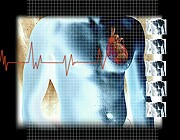
MONDAY, May 23 (HealthDay News) — For people who show no symptoms of heart disease, there is little short-term benefit to having their heart vessels scanned for plaque buildup, a new study suggests.
While interesting, new technologies such as CT angiography haven’t demonstrated in clinical trials that they are useful for asymptomatic patients. Moreover, CT angiography is not needed to get the best treatment and the best prevention for heart disease, said lead researcher Dr. John W. McEvoy, a heart specialist at Johns Hopkins University.
“In asymptomatic patients, while it makes sense in some respects to want to know if there is any heart disease, studies to date don’t demonstrate that knowing whether or not you have coronary disease makes any difference to what can be done to change the outcome,” he said.
It’s patients with symptoms such as angina or shortness of breath who benefit from such scans and aggressive treatment, McEvoy noted.
“If someone has risk factors for heart disease, but no symptoms, the doctor would be best served by doing a good physical, taking a history and measuring risk factors and treating those risk factors,” he said.
“Patients, and everybody in general, tend to think that the new fancy technology may be the best test they can have to know whether or not they have heart disease,” he said. “But it doesn’t matter whether or not you have mild heart disease, what matters is whether or not you are living a good lifestyle.”
This includes reducing blood pressure, lowering cholesterol, eating healthfully, not smoking and staying active, McEvoy said.
The report was published in the May 23 online edition of the Archives of Internal Medicine.
For the study, McEvoy’s group collected data on 1,000 patients who had no symptoms of heart disease who underwent CT angiography. These individuals were taking part in a screening program in South Korea.
The researchers compared these people with another group of similar individuals who had not had CT angiography.
None of the patients in either group had chest pain or any other symptoms of heart disease. These men and women were an average of 50 years old, the researchers noted. In addition, people in both groups were given standard care advice on how to lower their risk for heart disease.
McEvoy’s team found that 215 of the people who underwent CT angiography had plaque buildup. These patients, based on this finding, were more likely to receive aggressive care.
In fact, they were 10 times more likely to have an exercise stress test, a nuclear medicine scan or cardiac catheterization, compared with those who did not have CT angiography, McEvoy’s group noted.
In addition, those who had plaque buildup were three times more likely to be prescribed a cholesterol-lowering drug and four times more likely to be taking aspirin to thin their blood to prevent clots.
After 18 months, one person who had CT angiography developed chest pain called unstable angina, and one person who had not had CT angiography died of a heart attack, the study authors noted.
McEvoy said 18 months might be too short a time to see whether the aggressive treatment given patients who underwent CT angiography was worthwhile.
“You could make an argument that it should. Maybe over five to 10 years there might have been a difference. But even if we found a difference, we wouldn’t know for sure if the CT angiogram was the cause of an improved outcome, because this was not a randomized trial,” he said. “This was a preliminary study.”
Dr. Gregg C. Fonarow, a professor of cardiology at the University of California, Los Angeles, said the use of CT angiography in asymptomatic patients has not shown a proven benefit.
“Cardiovascular risk assessment and noninvasive detection of atherosclerosis in asymptomatic individuals using CT angiography has been adopted into clinical practice by certain physicians without clear evidence that clinical outcomes are improved with this testing,” he said.
While screening CT angiography was associated with moderately higher use of aspirin and statin therapy in those with positive scans, there was an increase in non-guideline-based testing and other procedures without any difference in outcomes in those with CT angiography screening compared with those without screening, Fonarow said.
“The use of CT angiography in asymptomatic individuals may expose patients to potentially unnecessary radiation, may result in additional non-guideline-based testing and revascularization procedures, and has yet to be demonstrated to improve clinical outcomes,” he added.
More information
For more details on heart disease, visit the U.S. Centers for Disease Control and Prevention.

